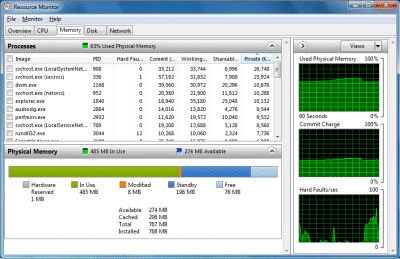Yesterday I installed Windows 7 Professional on an older PC – it dates from 2001 or possibly 2002, and has a Pentium 4 1.8Ghz on Intel’s 845 chipset. Only 768MB RAM is installed – generous for XP in those days, but below the 1GB minimum spec for Windows 7.
I thought I would try it anyway. It turned out that Windows 7 installed without complaint – I believe you have to go down to 512MB before setup actually protests – and I was impressed with how smooth the process was. There is a Creative Audigy soundcard installed; and after logging on for the first time, Windows automatically downloaded an update which got this working. Device Manager shows no errors other than a “PCI Input Device” which I suspect is the joystick port on the Creative soundcard. A cheap USB wireless card was recognized first time, and the add-on USB 2.0 card also works fine.
I am also impressed by the performance. I stuck on Office 2007, ran up Word and Excel with a couple of documents open, and looked in Resource Monitor:

This shows 274MB still available; at this level of use, the machine is not under any pressure.
It is not fair to make a direct comparison with XP since it had been installed for a while and would have built up a bit of cruft. However, Windows 7 is subjectively slightly faster, if anything, and you could not say that for Vista on the same machine.
I am not recommending that anyone runs Windows 7 on a below-spec machine, but I found it interesting nonetheless.
I’ve also been pleased with the in-place upgrade I did on my laptop, a 2006 Toshiba M400. This machine is much younger of course; though at three years old laptop batteries tend to die and sometimes it is hard to justify the cost of a replacement. This one is running so well that I have replaced the battery.
I am sure the industry is counting on Windows 7 to drive sales of new machines. There is another angle on this though, which is that old machines that were not much fun with Vista may be rejuvenated by a Windows 7 installation. Extending their life is good for the balance sheet as well as for the environment, so I am all in favour.
Yet another angle on this is that there is more incentive to go through the pain of reinstalling the operating system for Windows 7 than there was for Vista. I suspect this means that we will see rapid adoption, exceeding most expectations. For developers, that means it will pay to support Windows 7 features like the new taskbar sooner rather than later.
Been running the RC for a few months on a P4 2.6Ghz Touch PC with only 512MB RAM and 32MB RAM stolen for graphics. Its perfectly usable for web browsing.
I also have it on a Pentium M 900Mhz tablet PC with 768MB RAM and 64MB stolen for graphics. The latter you do have to be a bit patient with especially as both are stuck with standard SVGA graphics drivers. That said, they are both usable and may be even better with RTM as my Core 2 Duo laptop seems to run a lot better on RTM than it did on the RC, and the RC ran well until something messed it up causing disk thrashing for up to half an hour on bootup (not sure if it was SonicStage, Daemon Tools, or something else entirely).
I used Vista Home Premium for 1 year on a P4 1.7GHz, 768MB, NVIDIA Geforce 6200 (Aero enabled). It worked very well.